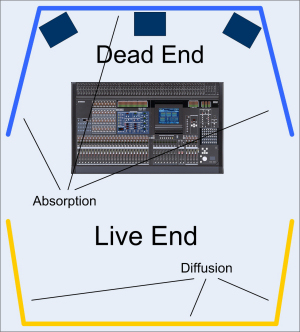
The Live End - Dead End concept is one of the older standards for control rooms of recording studios. The dead end of the room is the front side behind the rear of the control speakers and the live end is opposite wall of the room, the rear side of the listening position. Dead end means treatment of the wall surfaces with broadband absorptive materials that will absorb sound energy over the entire frequency band to a relatively high degree.
The concept works on the idea that the control loudspeakers have a reflection free zone behind to avoid disturbing reflections on the front wall, that would interfere with the signals from the loudspeakers.
The control room has a different acoustic purpose than the recording studio itself, the recording room. Generally, the listener in the control room wants only to hear the direct sound from the control loudspeakers without any influence or coloration.
This concept is not working in accordance to the surround standard ITU-R BS.775-2, there all channels nedd to have the same electroacoustical and acoustical properties. The Live End - Dead End situation creates different acoustical conditions for the front channels and the surround channels !

The opposite wall behind the listening person(s) is normally treated with sound diffusers to reflect sound diffuse back into the room to create a certain live-ness in the room. Because of the physical distance from the listening position to the back (diffusive) wall an early time gap between the direct sound and the arrival of the first diffused reflections will be generated.
This approach is also used for voice booths, rooms for voice recording or booths for announcing persons. Here the goal is to get a clean direct sound free from early reflections but followed by a normal ambient sound decay.
The talking person is placed with his/her back to the absorbent wall (and absorbent ceiling parts and floor) with the microphone in front of him/her. No reflected sound will enter the microphone from the dead end behind the talking person but a small early time gap and a natural small sound decay will be created by the diffuse reflected sound on the opposite 'live' wall in front of the talking person (behind the microphone).